According to surveys in needlewomen's magazines, cross stitching is considered the most popular hobby. It is difficult for beginners to master this skill if they do not know all the basics of creativity. Step-by-step descriptions with photographs will help you get acquainted with the rules of embroidery.
Materials and tools for work
To start cross stitching, you need to purchase the following materials:
- Canvas – a special fabric for embroidery. Its weaving is done in such a way that small gaps remain for the needle to enter and exit. The canvas can be white or colored. It is sold by the meter in stores, and manufacturers include pre-cut patches in embroidery kits.
- Embroidery hoop - is a special design for stretching the canvas. They are necessary for convenience, as well as to prevent deformation of the fabric.
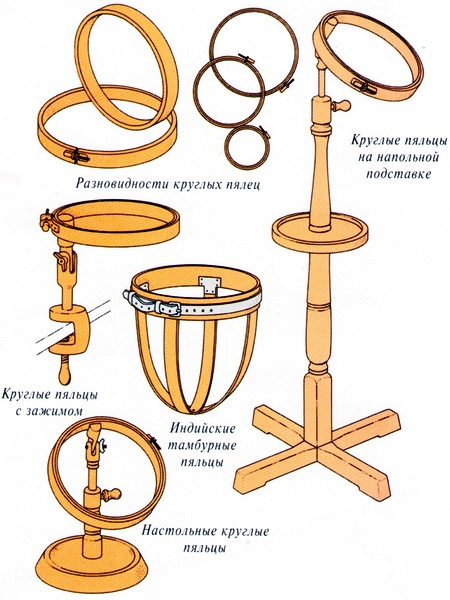
There are round and square hoops. They consist of 2 parts, one is inserted into the other, and the canvas is placed between them. On the large part there is a screw that is screwed in, which regulates the tension.
Plastic hoops are cheaper than wooden ones. For large canvases, there are floor-standing designs on legs that allow you to work with embroidery with both hands.
- Needles for embroidery differ from sewing needles. They have a rounded tip, which will not allow you to get hurt, and a long, narrow eye. It excludes getting caught between the weave of the fabric, embroidery needles easily pass through special gaps in the canvas. For each canvas size, you need to choose the right needle size.
| Canvas number | Needle number |
| 14 | 22-24 |
| 16 | 24-26 |
| 18 | 27 |
For fabrics with non-standard sizes, you need to select the needle size manually. From the edge, through one gap, you need to pass the needle. It should go smoothly, without getting stuck.
- Mouline thread – a classic type of cotton thread for cross stitching. There are more than 20 well-known manufacturers of these threads. They have a wide range of colors, and the embroidery kits include the required number of skeins, selected by color. For festive work, there are threads with lurex.
- Marker is necessary to mark the canvas into squares for ease of work, as well as to indicate allowances for the hoop. A regular marker will not work, because the rod of a special felt-tip pen is filled with washable ink and after washing, there will be no traces of the markings on the back of the embroidery.
- Scissors are needed for cutting threads and canvas. They should always be sharpened. It is better to buy a pair of scissors, some small, others a little larger.
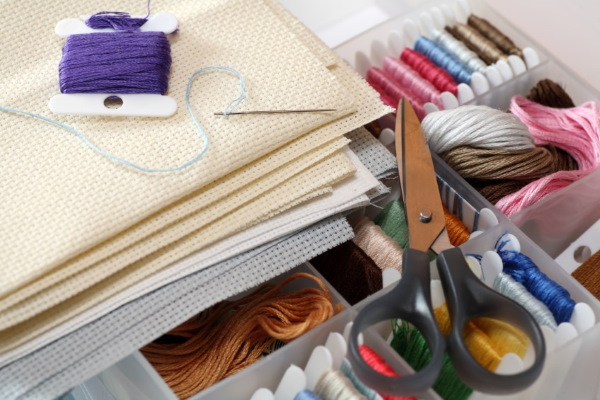
There are other additional embroidery supplies, such as thimbles, floss tucks, and storage kits. You can learn to cross stitch without them.
Cross stitching techniques
Cross stitching (for beginners, a step-by-step description with photos is provided) is performed using 6 different techniques:
- Classic or English.
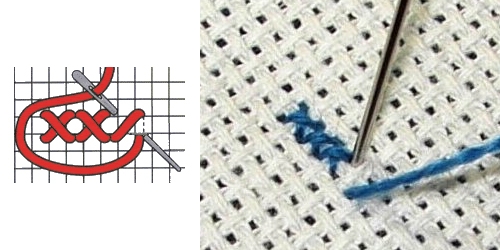
Each cross is embroidered separately. It is best to start learning embroidery with it.
- Danish technology.
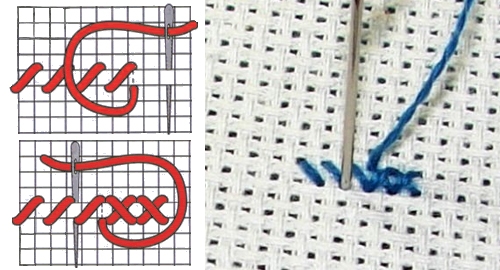
The first row is embroidered with the bottom stitches, and then they return in the opposite direction, placing the top stitches.
- Diagonal simple or double.

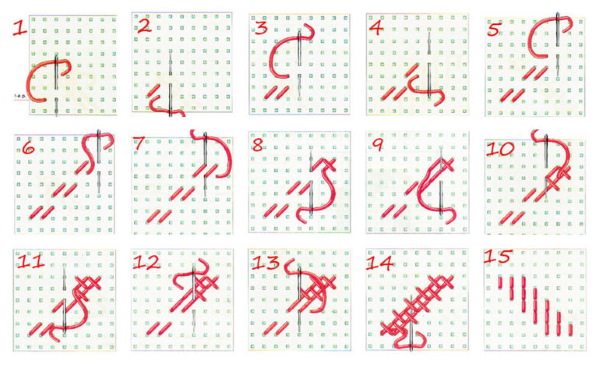
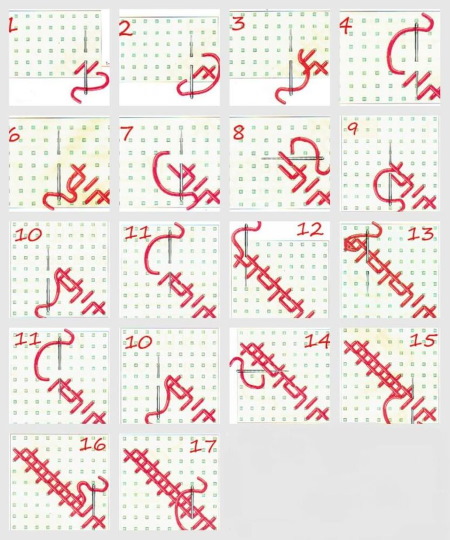
In the 1st case, the stitches are sewn from the bottom up and vice versa. In the double method, the embroidery begins with 2 single stitches simultaneously in 2 parallel squares. Reaching the end of the row, they return and make crosses.
- Vertical technique.
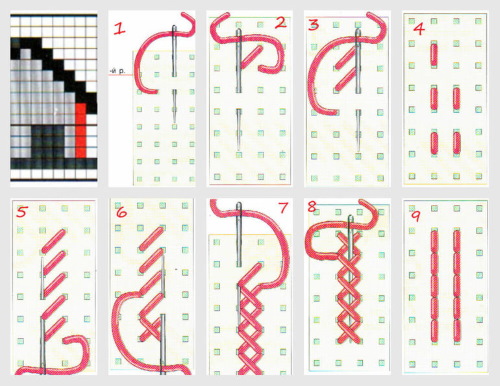
From top to bottom, make vertical stitches, and when returning, pull the thread diagonally to create crosses.
- Fragmentary embroidery or enlargement of crosses.

A separate color area needs to be filled with diagonal stitches starting from the upper left corner. Then from the lower corner they rise, stitching stitches in the opposite direction.
- Tapestry technique.

This method is considered the fastest and most thread-saving. The stitches are sewn in a half-cross pattern, where the rows are connected in a checkerboard pattern.
You can only embroider without using a hoop using the classic method. Other techniques require moderate canvas tension, especially tapestry. A drawing made on loose fabric will be very difficult to straighten.
Selecting a canvas
The fabric for embroidery varies by type, the size and convexity of the crosses depend on this parameter. The most common canvas is No. 14. There are 55 cells per 10 cm. Other types are described in the table.
| Number | Number of cells per 10 cm | Scope of application |
| 11 | 43 | Making Large Crosses |
| 16 | 63 | Raised embroidery |
| 18 | 70 | Small cross stitch |
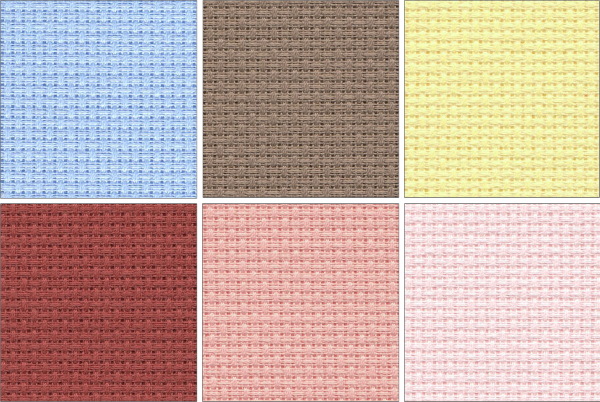
There is a thick weave overlay canvas with large threads. It is sold starched and is used as a lining when embroidering on plain fabrics.
Beginners are advised to choose quality material. Popular manufacturers producing good canvas include Aida, Zweigart and Astra.
Types of seams
Classic embroidery consists of a simple cross stitch, but there are 5 more types of stitches that help make the design more interesting:
- Half cross or ½ cross.
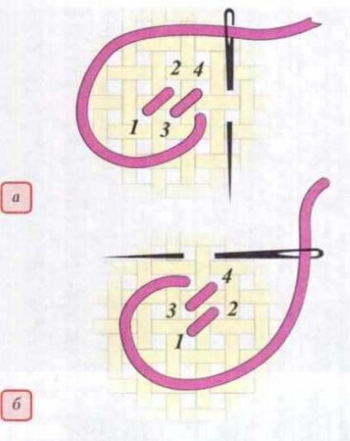
The stitches are embroidered in the same way as the tops of full crosses. Usually, their direction is indicated on the diagrams. Small diagonal stitches can be directed upwards or downwards.
- ¼ cross stitch.
This type of stitch has a second name: Petite. In French it means “small”. The stitch is a small half-cross or full cross, which is smaller than the classic version by ¼. It is stitched halfway through one cell, under the threads of the fabric. In one cell, where in the classic version only 1 cross is placed, 4 such stitches fit.

- ¾ cross stitch.
A small stitch is taken from one upper corner to its middle. The next stitch should be perpendicular. The direction of the small stitches is indicated on the diagrams. It should be the same as other crosses in the entire embroidery.
- Backstitch.

These stitches give the embroidery a finished look. Backstitch is done with dark colored threads. To clearly outline the outline of the design if it merges with the background.
- French knot.
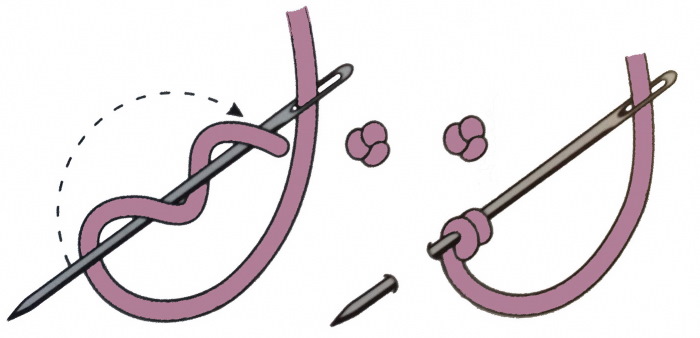
These stitches give the design an unusual relief. They are used to create unusual designer embroideries or to decorate a separate fragment that should stand out from the overall design.
To learn how to make different types of seams, you can practice on small pieces, size 10 cm x 7 cm.
How to Mark Out a Canvas
Cross stitching for beginners (step-by-step instructions with photos are provided below) will not be a difficult task if you mark the canvas correctly before starting work.
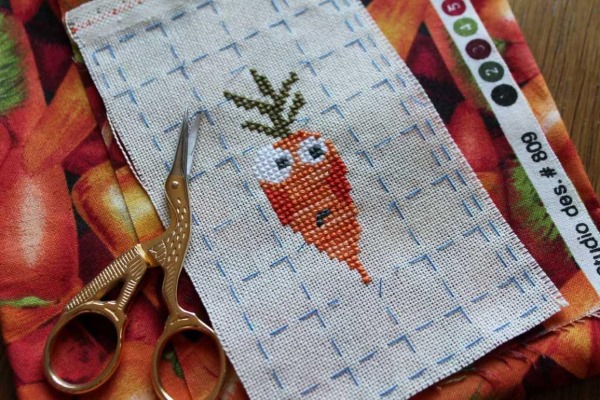
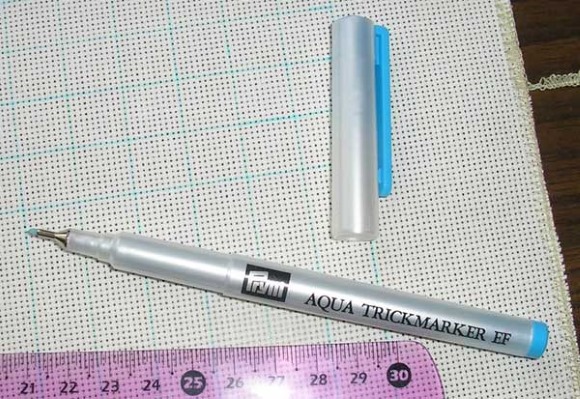
Most of the patterns are divided into squares, 10 x 10 cells. The total area of a square is 100 cells. It is necessary to line the canvas. You can start from the middle or from the corner.
Procedure:
- The canvas is laid out and ironed.
- Now you need to determine the center of the canvas. To do this, fold it in half, first horizontally, then vertically. The intersection of the lines will be the center point.
- Count 10 cells on each side and draw lines using a ruler.
Marking can be done with washable markers, water-soluble threads or disappearing ink.
How to secure the thread
It is not recommended to secure the threads with regular knots. When washed, they easily come untied and also make the surface of the embroidery uneven and can be felt from the front side.
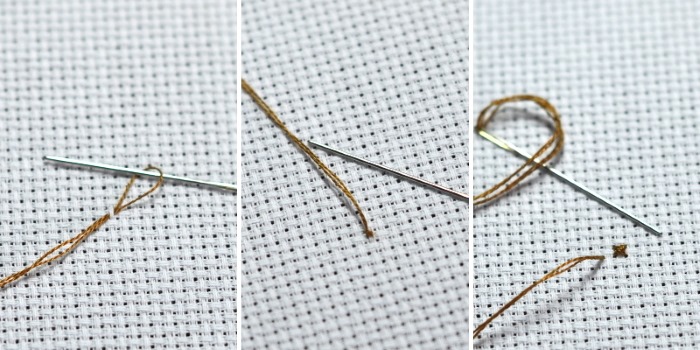
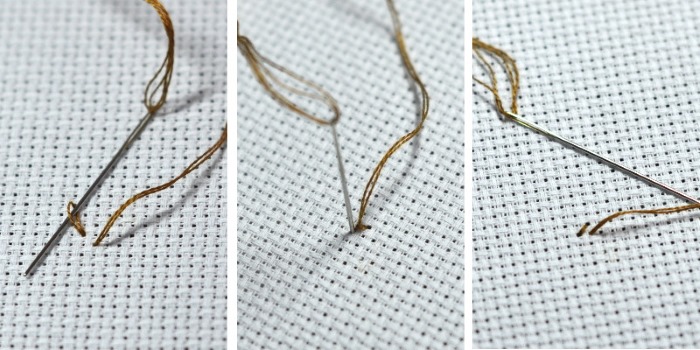
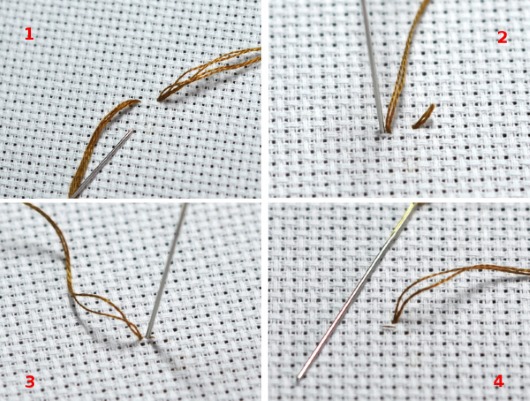

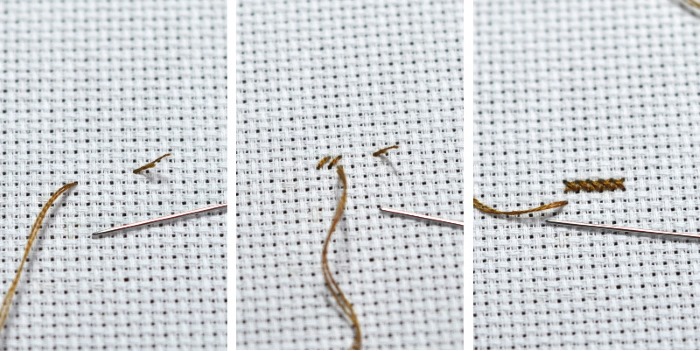
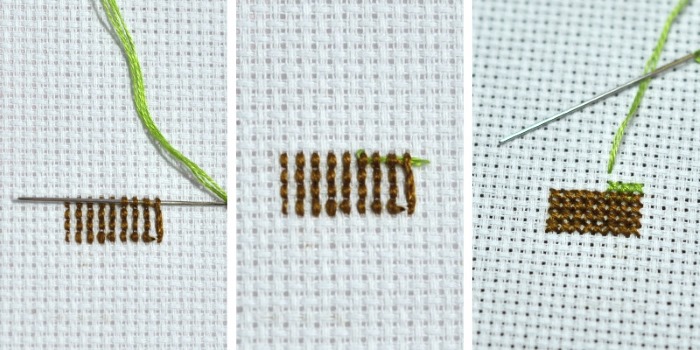
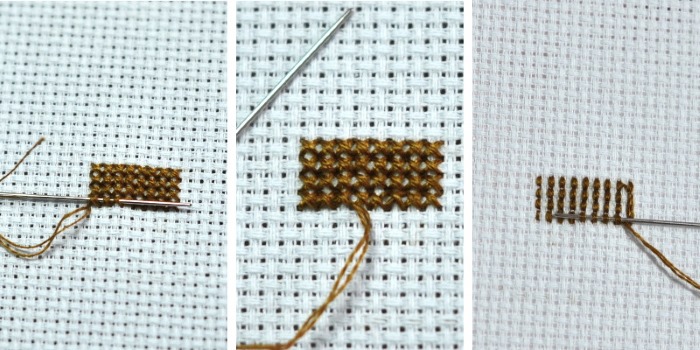
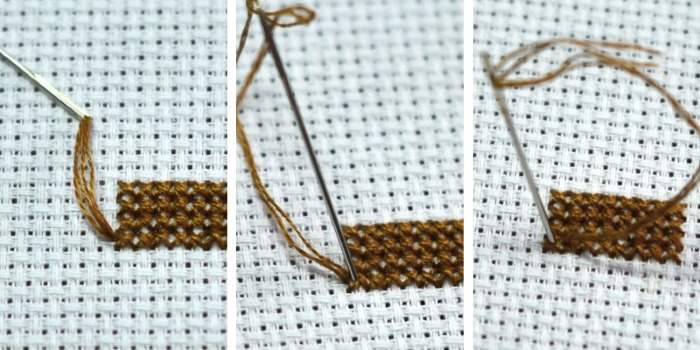
At the beginning of the work, you can fix the thread in a looped way. To do this, bend the thread and thread it into the needle. From the back side, insert the needle into the first cell and come out on the front side of the canvas. The loop should remain on the other side. Pull the needle out to the back and thread it through the loop. Do not tighten it too much, this will lead to deformation of the cell. You can start cross-stitching.
When the working thread runs out, you need to carefully attach a new one. To do this, carefully pass it under five stitches from the back side and secure it with one segment of the back stitch.
Cross stitching is completed in a similar way to the attaching method. There should be about 5 cm of free edge left to the end of the thread. Beginners should practice on a small piece of canvas, repeating the steps step by step so that no difficulties arise during the work. Below are photos showing what the attached thread looks like.
Smooth color transitions
To change one color to another, and the transition remains unnoticeable, you can use 2 methods: gradual replacement of thread or fractional crosses.
In the first case, you may need a palette of floss. To smooth out the sharpness of the transition, you need to choose an intermediate color. For example, from yellow, a smooth transition to green is required. Several thin fragments are pulled out of the yellow thread and green is added. This continues until the color changes completely.
Another option: knit the last row with 3/4 fractional stitches, angle up. Note the color of the thread and embroider in the opposite direction along the same cells, finishing the row so that it looks like it was stitched with a regular cross.
How to work with the scheme
The patterns can be colored or black and white, but with symbols for each color, as well as colored, with symbols for different stitches. It is believed that working with colored patterns is the easiest, since the picture is already visible, all that remains is to select the threads and count the cells.

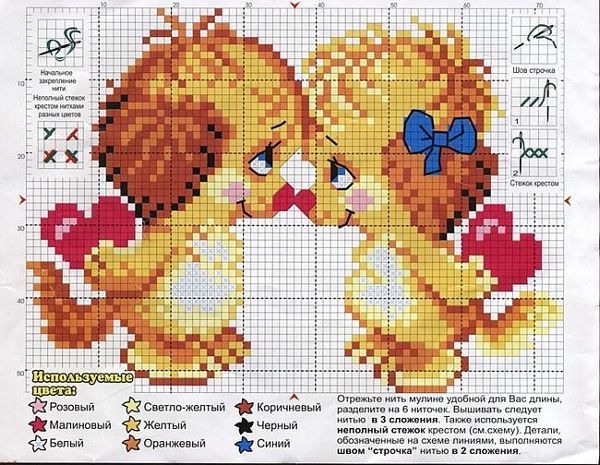
The markings on the black and white diagrams are small symbols that are explained at the bottom of the drawing. Usually the diagrams are already divided into squares. All that remains is to mark the canvas and get to work.
What designs are used for cross stitching
Usually, images made in cells are used. These can be small pictures, monochrome or color, and experienced craftsmen are able to embroider landscapes or portraits.
To create your own unique design, you can use a regular notebook in a box. You need to select colors and then transfer them to the fabric, counting 1 cell of the notebook as a cell on the canvas.
Easy cross stitch patterns on squares
Cross stitch for beginners (step-by-step description with photos) should start with children's patterns. There are no complex color transitions or difficult to perform stitches. For example, you can consider a detailed master class on embroidering a flower according to the pattern.
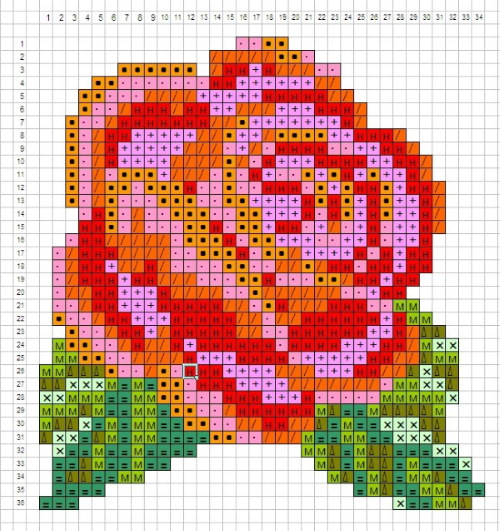
Instructions:
- Smooth out the canvas. Find the center and mark it with a dot.
- From the mark, the marking of squares begins.
- The embroidery starts from the central square. The thread is inserted into the needle and secured on the back side.
- It is not necessary to embroider strictly in rows; you can try filling in fragments of each color separately.
- Once you have filled one section with crosses, you can begin embroidering another.
- First, the upper part of the design is embroidered, then the lower one.
- Finally, the embroidery is ironed from the reverse side.
If a water-soluble marker was used for marking, the canvas should be rinsed in cold water, dried, and spread out on a flat surface. When dense embroidery still seems difficult, it is better to use black and white contours. Here, there is no need to change the color of the thread or tear it off.
Cross Stitch Rules for Beginners
In order for the embroidered work to look beautiful, you need to follow the following recommendations:
- Treat the edges of the canvas with PVA glue, interlining or hem them. This prevents it from fraying and gives the work an embroidery look.
- If the finished embroidery is going to be washed, you need to make sure the quality of the thread dyeing before you start working. Take 1 thread of each color and wet them in water heated to 95 degrees. Then run the wet floss over the white fabric. Low-quality material will leave colored marks. It is not recommended to use it for embroidery, as such threads will ruin the work.
- When threads for embroidery are selected manually, it is necessary to straighten each skein and compare the shades, as well as the thickness of the threads. If you use different materials, the transition will be very noticeable in the work.
- To select a more precise shade of floss, you need to pull out the threads and place them on the canvas, because in a bunch the color visually becomes brighter.
- If you don’t have a hoop at hand, you can embroider on vinyl canvas, which is rigid and resistant to deformation.
- The optimal length of the working thread is 45 cm. If it is too long, it will get tangled, and if it is too short, it will quickly run out.
- If you plan to embroider on linen or cotton fabric, you need to wash and iron it beforehand. The fabric may shrink and the embroidery will be ruined.
- When embroidering on dark canvas, you can slightly increase its tension in the hoop. This will make the holes for the needle entry more visible.
Needlewomen recommend starting cross stitching with ready-made creative kits. They come with marked patterns, threads of the required colors, and canvas.
When creating works with your own drawing, or using schemes from the Internet, you need to follow simple recommendations and study all the basics in detail. Lessons with step-by-step descriptions and photographs can help with this.
Article formatting:Natalie Podolskaya
Video about cross stitching
Cross stitch for beginners:
